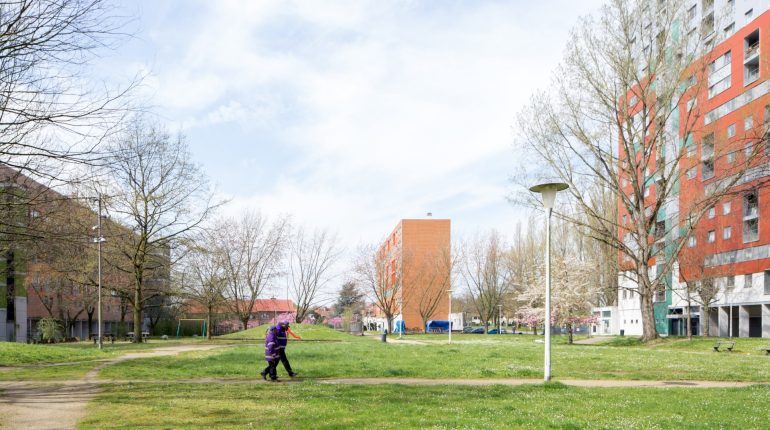The government of Brussels has selected the three new areas for this twelfth series of sustainable neighbourhood contracts. The selection process has been marked by the Covid crisis and difficulties linked to housing conditions, in particular for vulnerable groups. That is why the areas chosen all feature large social housing complexes. New areas which have never had access to a neighbourhood contract before are thus being considered for the first time. The needs are considerable; this is where the urban renovation policy really comes into its own.
Versailles, in the Ville de Bruxelles area
At the edge of Neder-over-Hembeek, Cité Versailles is a vast social housing complex built between 1968 and 1983 in a rural area. It features medium and high rise residential buildings, a mix of different architectural styles, and a green space running through it. Its morphology, based on the principle a park inhabited by people, resembles other social housing developments in the Brussels region such as the Peterbos neighbourhood in Anderlecht or the Cité Modèle in Laeken. Isolated from the rest of greater Brussels, the Versailles neighbourhood is one of the lowest-income areas in the ZRU (Urban Revitalisation Zone) and faces significant social, environmental challenges.
Deux Cités in Forest
Deux Cités covers approximately 13 ha and encompasses the Cité-Jardin Forest Vert and Les Blocs Jaunes de la Nouvelle Cité estates. An agricultural area at the beginning of the 19th century, the neighbourhood progressively became urbanised with the arrival of manufacturing and industrial activities which took advantage of the presence of the Geleytsbeek and the nascent rail network. Names of roads such as Verrerie (Glassmakers), Teinturerie (Dyeing Factory), Soierie (Silk Factory), make reference this heritage. The recent renovations in Les Deux Cités, as well as the many ongoing nearby projects, call for closer attention to be paid to the needs of current and future residents to provide them with the necessary facilities and a welcoming environment.
One hundred years later, let’s bring magic back to Cité Moderne in Berchem-Sainte-Agathe
This sustainable neighbourhood contract, awarded for the first time to the municipality of Berchem-Sainte-Agathe aims to staunch the slow process of decline that is affecting this early 20th century gem of modernist urbanism. It aims to rekindle the spirit which inspired the founders of the Cité Moderne a hundred years ago. To awaken a contemporary energy and ambition reflective of society as it is today and the diverse communities of which it is composed.
The City of Brussels, the municipality of Forest and the municipality of Berchem-Sainte-Agathe are in search of teams to devise the basic scheme and produce an environmental impact report within the timeframes and as indicated in the Order dated 6 October 2016.
Each team may apply for one, two or all three CQDs.
SKILLS
- Architect – Town Planner
- Experience in programming
- Experience in participation
- Skills to produce a satisfactory environmental impact report
AWARD CRITERIA
- Quality of the score for district vision 40%
- Quality of the score for method 50%
- Ability to summarise scheme operations and actions 10%
BUDGET AND APPROXIMATE TIMING
- For each of these 3 contracts, fees are set at about €105,000 net of VAT (program and EIR)
- The contracts must be assigned by mid-July.
- For each of the 3 contracts, disbursements of €1,500 will be allocated to each team invited to bid which submitted a consistent tender based on award criteria but not selected.
If you are interested in the mission, please e-mail, before the 10th of May at 12pm the team of the bouwmeester maitre architecte at appel-oproep@bma.brussels showing your interest, motivation and experience and giving your contact details and/or those of the planned team (on a maximum of 1 attached A4 sheet). Please complete a separate, specific sheet of A4 for each CQD in which you are interested.
